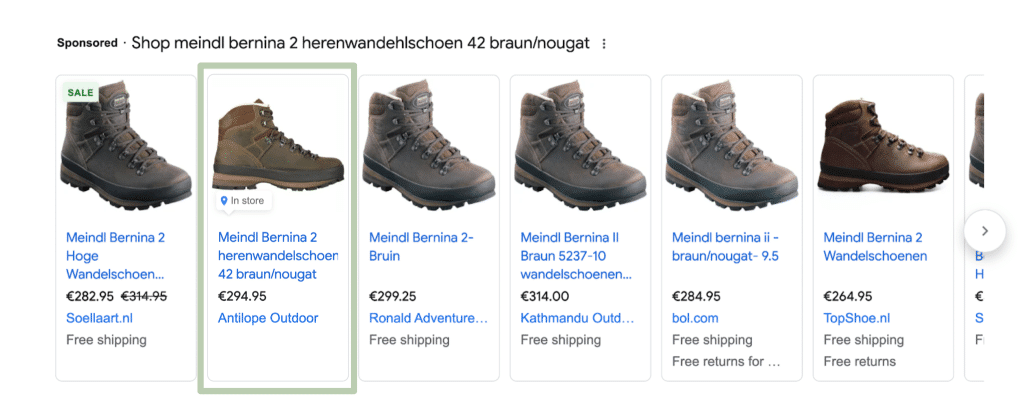Experiments in Google Ads
Within Google Ads, it is possible to set up experiments. This functionality allows you to test the effect of intended changes to your account. The big advantage of this is that you reduce the risk that a change will have major negative consequences on the results of your campaigns. Always had an improvement idea but afraid it would negatively impact the results of your campaigns? Then read on quickly about experiments in Google Ads.
Setting up experiments
Within Google Ads, it is possible to set up experiments within the interface under the heading “Drafts & experiments.” Before setting up an experiment think carefully about what you want to test and based on which metric you want to determine whether a test is successful or not. Since Google Ads campaign are generally very performance-based, it is advisable to count against conversion-related metrics such as: conversions, conversion rate, cost per conversion and ROAS. Once all that is clear, you have the following options within Google Ads to set up a test:
- Campaign experiments
- Advertisement variation (ad variation)
Campaign Experiments
Campaign experiments is the right option if you want to test something that is not about ads or landing pages. The steps for setting up a campaign experiment are as follows:
- Go to “Drafs & experiments” and choose “campaign drafts.”
- In doing so, select the campaign you want to test and give the draft a clear name and description. Then click save.
- You have now created a copy of the campaign you want to test. Within this campaign, you make an adjustment in terms of what you want to test. The advice is not to make more than 1 adjustment, otherwise you won’t know for sure afterwards which adjustment caused the effect. An example of an adjustment is testing a bidding strategy this can be done by adjusting under settings the bidding strategy from manual to maximize conversions. Then click “apply” and ”run an experiment”.
- A new screen opens where you need to fill in some characteristics and settings for the experiment:
- Name and Description: Again, provide a clear name and description here.
- Start and end date: The recommendation is not to set an end date, ultimately you don’t want to close the test until you have enough data to say something about it.
- Experiment split: Normally 50% is the best option, however, this is entirely up to you. If you are testing something that could have major consequences then you can choose to bring this percentage down. The lower you set the percentage, the longer it takes before you have enough data to say something reliable about the results.
- Advanced options: Here you can still choose to distribute the experiment based on searches or cookies. The purest is to choose cookies, this way you make sure that someone always sees the same variant. Then click save.
- After saving, the experiment appears in the campaign overview, this can be identified by the experiment icon that Google adds for the campaign.
Ideas for campaign experiments
There are countless things you can test in a campaign experiment. Below is an overview of two campaign experiments that could have a lot of impact:
- Testing bidding strategies: A bidding strategy can have a very big effect on your campaigns, especially if you are currently bidding manually and are going to experiment with automatic bidding strategies.
- Ad scheduling: Testing when your ads are displayed can also be very valuable. An example of this is testing the effect of not displaying between 12:00 and 7:00 in the morning.
Advertisement variation (ad variation)
If you want to experiment with your text ads or landing pages, then ad variation is the right option. The steps for setting up an experiment for ad variation are as follows:
- Again, go to “Drafts & experiment,” then choose “ad variations.”
- Then choose the campaigns in which you want to customize ads and click next.
- Then choose what you want to replace and specify what you want to replace it in. Then click next.
- The final step is to specify the characteristics and settings for the experiment:
- Variation name: Provide a descriptive name.
- Start and end date: Please indicate the start and end date of the experiment. The advice is not to enter an end date because you don’t want to stop the experiment until you have enough data.
- Experiment split: The percentage you get to see new variation. It is best to leave this at 50%, which is the quickest way to get enough data to analyze the experiment.
Ideas for ad variation experiments
Even with ad variation, you can test a lot of things with an experiment. Below are two ad variation tests that can be very valuable:
- Testing landing pages: With Google Ads, you can send quality traffic to a website, but ultimately you have little influence on the conversion rate. The website must ensure that a quality visitor actually converts to a customer. Therefore, it is very valuable to test various landing pages.
- Testing USPs: Within ads, it is important to communicate your company’s added value. Which USPs resonate best with your target audience is a question you can answer with an experiment.
Analyzing an experiment
Analyzing an experiment has been made relatively easy by Google Ads. Under “campaign experiments” or “Ad variations,” click the name of the experiment or ad variation. Then a screen opens with a comparison on various metrics of your control and variant. In doing so, choose the period you want to do the comparison and draw your conclusions. The points below are what you should pay attention to when drawing conclusions:
- Analyze the appropriate metric on which you want to measure the experiment.
- Make sure both the control and variant have enough numbers to say something useful about it. The recommendation is to maintain a minimum of 100 in both control and variant.
- Note that some changes such as bidding strategies have a learning period of at least 2 weeks. It is therefore advisable to run an experiment with bidding strategies for at least 4 to 6 weeks.
- Don’t make any major changes to your campaign during an experiment, and if you do make them do it in both control and variant.
- Google Ads automatically indicates when a particular metric has performed significantly better. Use this as a guide to draw a conclusion but don’t stare blindly at it.
If you have finally analyzed the experiment then you have the option to pause or continue the experiment. If the effect is negative, pause the test; if the effect is positive, continue the test.
Now that you know all about experiments within Google Ads, it’s time to set one up yourself. Experiment and improve your results!



